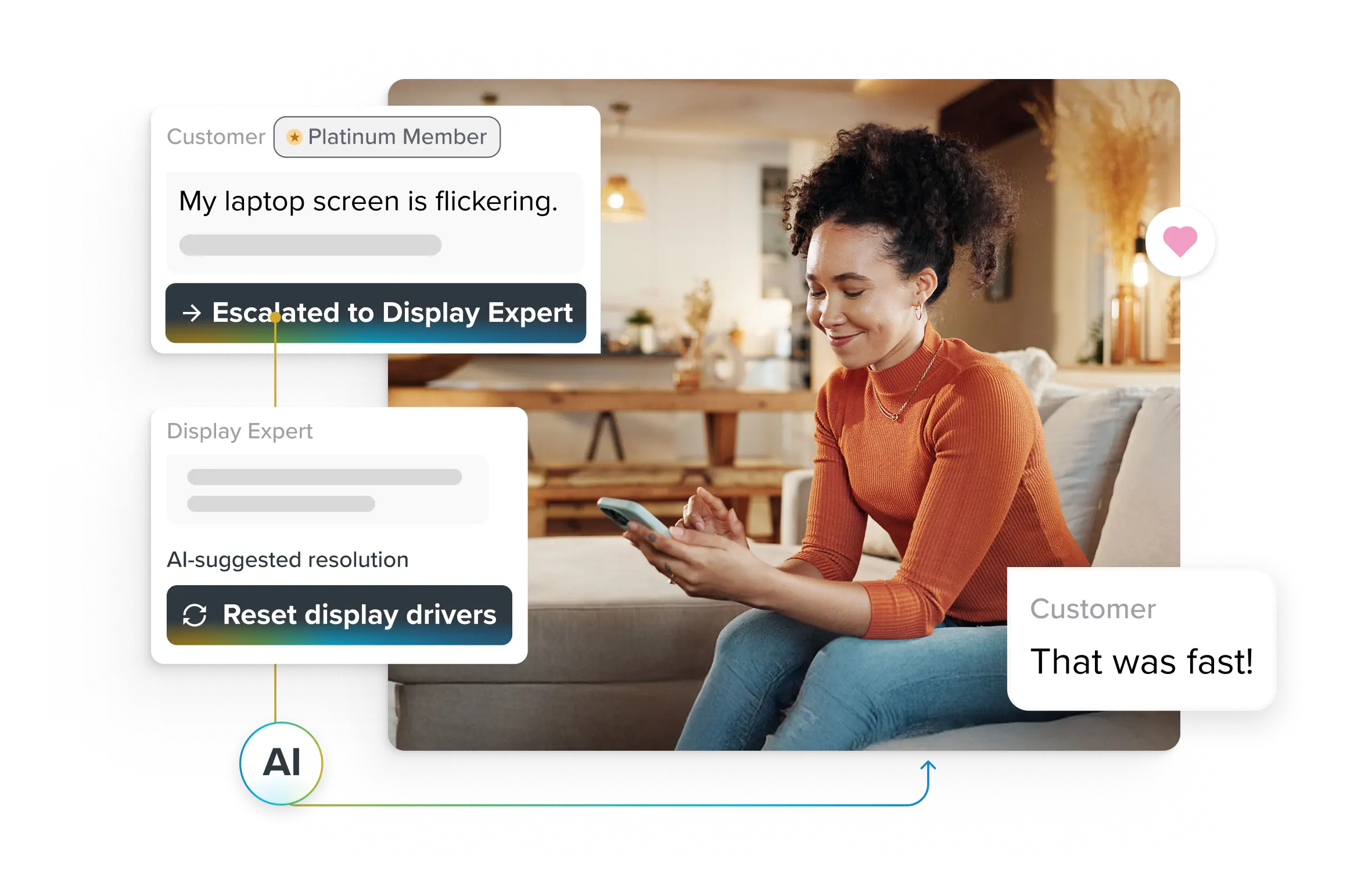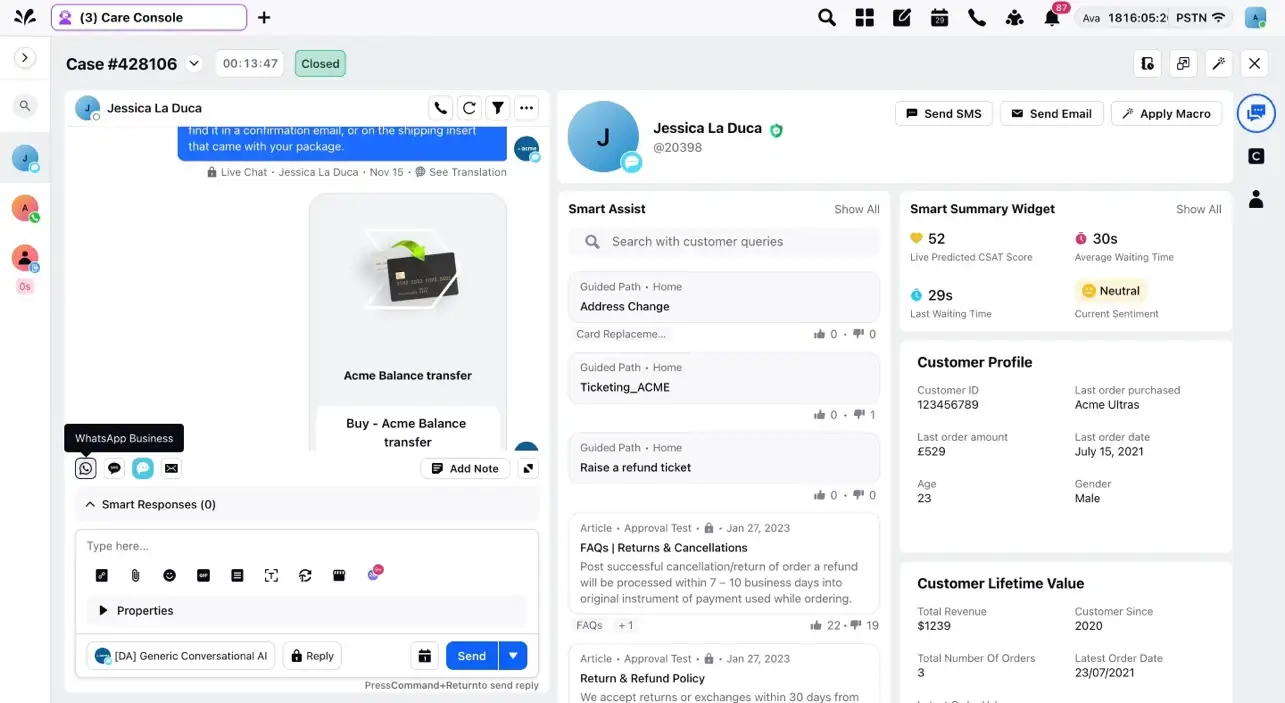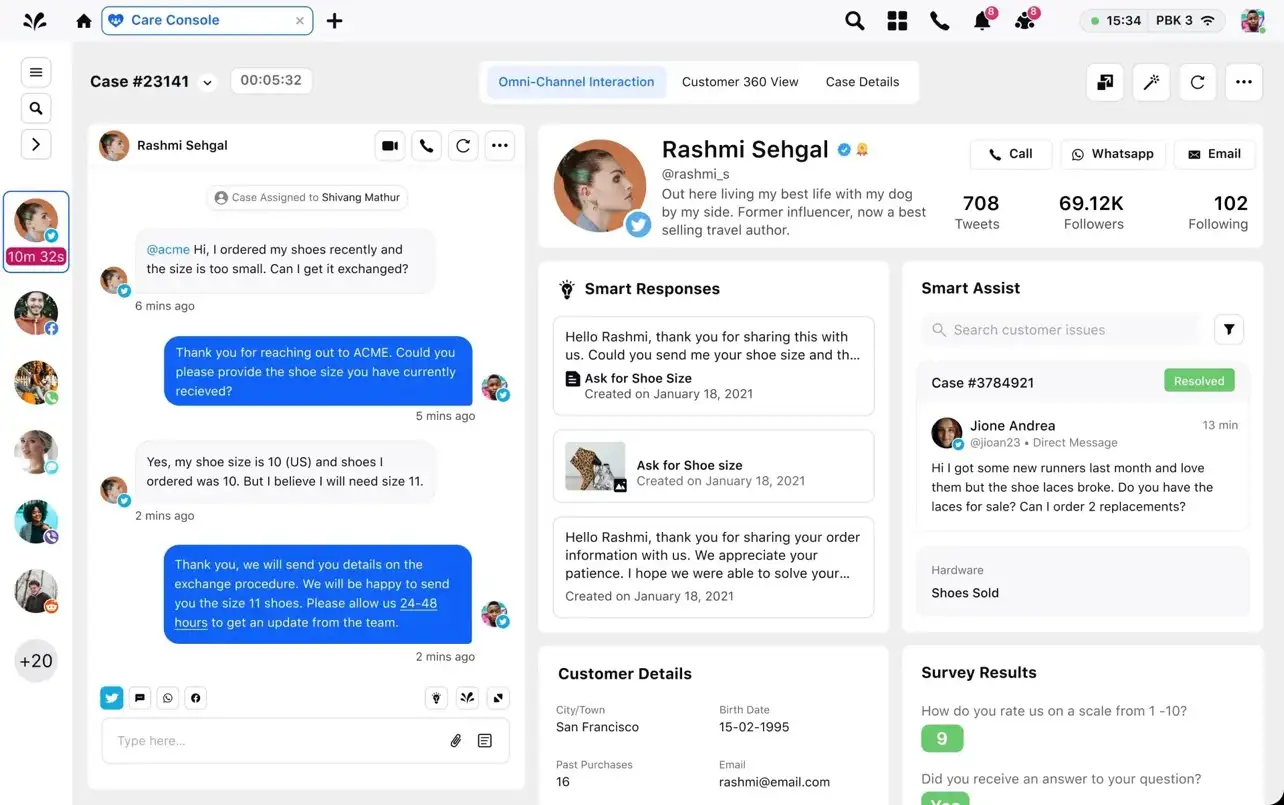Transform CX with AI at the core of every interaction
Unify fragmented interactions across 30+ voice, social and digital channels with an AI-native customer experience platform. Deliver consistent, extraordinary brand experiences at scale.

Step-by-Step Guide to Handle Angry Customer Issues
On October 10, 2023, a major software company faced a predicament when its latest update caused a critical system crash for several enterprise clients. One particularly irate IT manager, whose system decided to take an unscheduled "vacation" during a crucial project deadline, found themselves in a heated exchange with the company's support team.
The support team's suggestion to "try turning it off and on again" didn't quite hit the mark, leading to a viral debate on the appropriateness of their response.
This incident is a stark reminder that all brands inevitably encounter angry customers. As we delve into the strategies for handling angry customers and managing such situations, it is paramount for businesses to discern the root cause of customer annoyance.
In this blog, discover the underlying causes that often fuel customer dissatisfaction, explore effective strategies to rectify root issues, and most importantly, gain insights into adeptly managing interactions with angry customers. Furthermore, explore the instrumental role of AI in expediting issue resolution, ultimately contributing to customer happiness.
What are common causes of customer anger?
Understanding the root cause of customer anger is crucial for any business aiming to maintain high levels of customer satisfaction and loyalty. When customers express anger, it often stems from a few key issues:
· Product quality
Customers expect products to meet certain standards of quality and performance. When a product fails to meet these expectations, it can lead to customer frustration and anger. This could be due to defects, malfunctions, or simply not performing as advertised.
Imagine buying a premium coffee machine that promises barista-quality espresso, only to find that it leaks water and fails to heat up properly. This malfunction not only disrupts your morning routine but also falls short of the advertised quality, leading to significant frustration and anger.
Prioritize transparency in your sales process to minimize post-purchase challenges, preventing a flood of calls from frustrated customers to your inbound contact center.
· Service failures
Service-related issues are another common source of customer anger. This includes delays in service, unhelpful or rude customer service representatives, and failure to resolve issues promptly. Effective communication and timely resolution are essential to prevent service failures from escalating into anger.
· Unmet expectations
Customers have specific expectations when they purchase a product or service. If these expectations are not met, whether due to misleading advertising, overpromising, or underdelivering, it can result in significant dissatisfaction and anger.
Imagine signing up for a premium internet service that promises lightning-fast speeds and uninterrupted connectivity. However, after installation, you experience frequent outages and slow speeds that barely support basic browsing. This underperformance, compared to the advertised promises, leads to significant dissatisfaction and anger.
Navigating the complexity of angry enterprise customers
For enterprise customers, the stakes are often higher. Issues can be more complex, involving large accounts or bulk orders. Problems in these scenarios can disrupt business operations, leading to substantial financial losses and heightened frustration. Key points to consider include:
· Large-scale impact: Issues with large accounts or bulk orders can affect entire business operations.
· Financial implications: Delays or problems can lead to significant financial losses.
· Coordination challenges: Resolving issues often requires coordination across multiple departments.
· High expectations: Enterprise customers typically have higher expectations for service and support.
Imagine a large manufacturing company that relies on a software provider for its inventory management system. The software provider releases an update that inadvertently causes the system to crash, affecting the entire supply chain. This disruption halts production, delays shipments, and leads to significant financial losses.
Resolving the issue requires coordination between the software provider's technical support, development teams, and the manufacturing company's IT department. The complexity and scale of the problem highlight the critical need for robust service and support for enterprise customers.
Creative solutions for C-suite leaders
By understanding the root causes, business leaders can better prepare to address customer concerns and minimize customer dissatisfaction. At the very least, leaders should ensure:
· Proactive monitoring: Use advanced tools to predict and alert teams about potential issues before they escalate, preventing disruptions and ensuring smooth operations.
· Customer feedback loops: Regularly gather feedback from enterprise customers to understand their pain points and expectations, using this information to improve products and services.
· Cross-functional teams: Form teams from technical support, engineering, customer success, and communications to address complex issues quickly and holistically.
· Scenario planning: Conduct exercises to prepare for potential crises, ensuring teams are ready to act swiftly and effectively when real issues arise.
· AI-powered support: Enhance customer support with AI tools that analyze sentiment, predict issues, and provide real-time suggestions to improve interactions.
Background: Translink, a major public transport provider in Northern Ireland, serves over 1.5 million passengers weekly. They faced challenges in managing passenger feedback and ensuring timely responses across multiple social media channels.
Action taken: Translink implemented Sprinklr’s unified social media management and customer support solutions, using Sprinklr Social Self-Serve to publish content, monitor sentiment, and gather insights. Sprinklr Service Self-Serve was used to respond to feedback and inquiries quickly with automated support features.
Improvements implemented: With Sprinklr’s social listening and reporting capabilities, Translink could monitor sentiment in real time and create comprehensive reports to drive strategic decisions. They also leveraged AI-powered tools to provide faster, more consistent support.
Results: Translink achieved a 36% reduction in average case handling time and a 16% reduction in average first response time. The unified platform allowed them to manage eight brands across multiple social platforms efficiently, enhancing the overall passenger experience.
18 creative ideas to handle an angry customer
First and foremost, businesses must recognize that customers typically reach out only when they encounter difficulties that remain unresolved despite using your other channels, such as the website or helpdesk software.
Here are some proven tips on what to do and what to avoid when handling such interactions:
1. Introduce yourself
Begin by introducing yourself and your position in the company. This shows the customer that their issue is being taken seriously. Address the customer by name throughout the conversation.
2. Maintain your composure
Stay calm, even when a customer blames you for poor service. Losing your cool can worsen the situation.
3. Listen carefully
Allow the customer to express their concerns, actively listening to understand the root cause of the issue.
4. Acknowledge and apologize
Regardless of the complaint's validity, acknowledge the customer's situation and offer an apology. Take ownership of the issue to build trust and show commitment to resolution.
As Tony Hsieh, the late CEO of Zappos, said, "Customer service shouldn’t just be a department, it should be the entire company."
5. Be professional
Respond professionally without matching the customer's abusive style. Maintain a neutral tone and avoid becoming defensive.
Read More: 5 Ways of Responding to Customer Complaints [+ Real Examples]
6. Identify the real issue
Train agents on effective communication, guiding them on phrases to use and avoid. Encourage asking the right questions to understand the root cause and resolve issues quickly.
7. Summarize the problem
After listening to the customer's concerns, summarize and reiterate the issues to ensure both parties are aligned on the concerns.
Sprinklr AI+, integrated with GenAI models, automates case summarization and disposition, reducing the administrative burden on agents and improving customer service quality.
8. Employ historical data
Use historical data from the contact center CRM to understand the situation and provide informed suggestions.
Modern agent assist software recommends similar past cases right on the call, surfacing relevant knowledge base articles and guided workflows for seamless resolution. The AI-powered assistance leads to an increased first call resolution rate, significantly boosting agent productivity.
9. Identify the plan of action
Establish an action plan and communicate a clear timeline for resolution. Prioritize issues for premium customers or those at risk of churning.
10. Develop critical thinking
Consider temporary solutions like extending service until payment is secured or issuing prompt refunds to address immediate issues.
11. Shift to another channel (if necessary)
Transition conversations to phone or other channels if it accelerates resolution. Ensure the customer's comfort and avoid forcing a shift.
When considering transitioning your conversation to another channel, leverage omnichannel routing software for a seamless customer experience.
Omnichannel routing ensures that your agents can access a unified view of customer interactions across various customer service channels. This not only facilitates a smooth transition but also enables continuity in customer engagement.

12. Avoid putting them on hold for too long
Putting an already frustrated customer on hold can exacerbate the situation. Communicate politely if a hold is necessary for a swift resolution.
A modern unified agent console, powered by AI, equips your agents with real-time, relevant information and a comprehensive history of customer interactions across channels.

13. Apprise your manager if needed
Escalate the situation to a senior manager if necessary. While escalations may impact metrics like first call resolution (FCR) and average handle time (AHT), they show your company's commitment to customer sentiments.
Deep Dive: How to Do Escalation Management Effectively
14. Know your limits
Avoid overpromising and underdelivering. Accommodate reasonable requests but stand firm against unfair demands.
15. Know when to end the conversation
If a customer becomes too abusive or threatening, consider ending the conversation. Contact center compliance and call recording provide guidelines and legal safeguards for handling such interactions.
Sprinklr AI offers smart response compliance, ensuring each brand response aligns with established standards. Agents can provide feedback on compliance checks to enhance accuracy.
16. Take some time out
Recognize the emotional toll on agents dealing with angry customers. Allow them time between interactions to prevent call center burnout and foster a healthy environment.
17. Follow up
After resolving the issue, follow up with the customer to ensure their satisfaction, showing ongoing commitment to their experience.
18. Deploy call center technology
Utilize call center technology and contact center AI to streamline issue resolution and elevate the overall customer experience. Chatbots and virtual agents can respond immediately to common customer queries, expediting issue resolution.
GenAI-enriched platforms like Sprinklr AI+ provide humanized automated responses, ensuring empathetic and effective customer engagement.
Learn more about Sprinklr AI+
Why is it important to have a playbook to address angry customers?
Understanding and addressing the concerns of upset customers is crucial for several reasons:
· To prepare your agents: Having a step-by-step manual on the processes, policies and scripts agents can use when dealing with angry or dissatisfied customers allows quicker, more effective solutions.
· To allay revenge seekers: A study found that 74% of customers face troubles with products or services, and 9% are keen on settling scores with the company. Addressing their concerns can prevent negative actions.
· To retain the customer: Customer retention is cheaper than acquiring new ones. Satisfied customers are more likely to become brand advocates.
· To avoid negative word of mouth: Unhappy customers are more likely to share negative experiences. Resolving their issues can prevent them from badmouthing your brand and help maintain a positive image.
By understanding the unique challenges faced by enterprise customers and implementing strategic solutions, C-suite leaders can ensure high-quality service, minimize disruptions, and build lasting relationships with their clients.
Why you should keep your customer updated throughout the resolution process
Clear communication is essential in maintaining customer satisfaction, especially for enterprise customers who often deal with complex issues. Keeping customers informed throughout the resolution process is crucial for several reasons: it helps restore trust by providing regular updates on progress, next steps, and timelines, demonstrating transparency and commitment to resolving the issue.
This approach not only addresses the immediate issue but also fosters a positive, long-term relationship with the customer.
· Restoring trust and demonstrating commitment: When customers face issues, their trust in the business can be shaken. Regular updates on the progress, next steps, and timelines help rebuild this trust.
· Reducing frustration and enhancing customer experience: Uncertainty can lead to increased frustration. By keeping customers informed, businesses can alleviate some of this frustration. Knowing what to expect and when helps customers feel more in control and less anxious about the outcome.
· Leveraging industry benchmarks and managing expectations: According to a blog on call center KPI benchmarks by industry, sectors such as retail, e-commerce, and technology emphasize the importance of clear communication. For instance, the average handle time (AHT) in retail is around 5.4 minutes, highlighting the need for efficient and transparent communication to keep customers satisfied.
Learn from experience – Prevent future issues
Once a customer issue is resolved, it is essential for businesses to take proactive steps to prevent similar problems in the future. This involves working closely with customers to identify long-term solutions and leveraging their feedback to drive continuous improvement.
Analyze customer feedback
After resolving an issue, gather detailed feedback from the customer about their experience. Use customer surveys, follow-up calls, or feedback forms to collect this information. This feedback can provide valuable insights into the root causes of the problem and highlight areas for improvement.
Identify patterns
Look for recurring themes in the feedback. Are multiple customers experiencing similar issues? Identifying these patterns can help pinpoint systemic problems. For example, if several customers report long wait times, it may indicate a need to improve call center staffing or efficiency.
Implement improvements
Use the insights from customer feedback to make meaningful changes. This could involve updating training programs, enhancing product features, or streamlining service delivery. The goal is to address the root causes of issues to prevent them from recurring.
Monitor and adjust
Continuously monitor the effectiveness of the changes. Collect ongoing feedback to ensure the improvements are having the desired impact. Be prepared to make further adjustments as needed to maintain high standards of customer service.
Final thoughts
Turning angry customers into loyal ones is a challenging yet rewarding endeavor. According to a study, 66% of respondents find the need to repeat the same information across multiple employees or channels extremely frustrating. This common pain point can be effectively addressed by leveraging Sprinklr Service.
Built on the world’s only Unified Customer Experience Management Platform (Unified-CXM), Sprinklr Service empowers your agents with AI-powered tools and technology designed explicitly for handling irate customers. Here’s how Sprinklr Service can help:
· Conversational AI platform: Gauge customer intent and sentiment in real-time, allowing agents to respond more effectively and empathetically.
· Quality management software: Identify strengths and areas of improvement for each individual agent with AI-scoring parameters such as opening/closing quality, intro, active listening, empathy, and more.
· Sprinklr AI+: Sprinklr's GenAI integration actively moderates agent tone, fostering more empathetic interactions while intelligently flagging any responses that may deviate from compliance standards.
By utilizing these advanced tools, businesses can ensure that their agents are well-equipped to handle even the most challenging customer interactions, turning potential conflicts into opportunities for building stronger customer relationships.
For an in-depth product walkthrough of Sprinklr Service, register for a demo with our experts today. Transform your customer service experience and turn angry customers into loyal advocates with Sprinklr Service.
Frequently Asked Questions
Businesses can implement regular feedback loops, monitor social media for early signs of dissatisfaction, and train agents to identify and address potential issues promptly. Proactive communication and swift resolution are key to preventing escalation.
Acknowledge their frustration, empathize with their situation, and offer assistance in finding a solution. Even if the issue isn't your fault, showing a willingness to help can de-escalate the situation and build goodwill.
Agents should remain calm, listen actively, and avoid defensive responses. They should provide clear, concise information and involve a supervisor if necessary. Maintaining a professional and empathetic tone is crucial to managing escalations effectively.
Rebuilding trust involves acknowledging the issue, offering a sincere apology, and providing a clear plan for resolution. Follow up regularly to ensure satisfaction and demonstrate a commitment to preventing future issues.
AI can analyze customer sentiment in real time, provide agents with suggested responses, and ensure compliance with company policies. It helps agents respond more effectively and empathetically, improving overall customer satisfaction.

